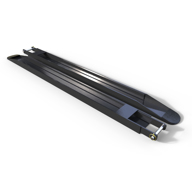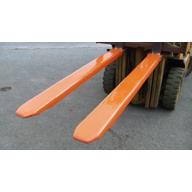
Forks, Covers & Extensions
Improve forklift efficiency with our attachments. Transform your machine into a versatile material handling solution.
Forks, Covers & Extensions
Forklift fork extensions
In companies where one forklift should be able to transport several lighter pallets at the same time in some situations and one heavy pallet in others, fork extensions come in handy. Fork extensions are retrofitted to forklifts when there is a need to increase the working space available on their forks. Lightweight, easy to install and relatively cheap, they allow you to easily adapt the internal transport vehicle to the specifics of the loads prevailing in a given period. What is the difference between the fork extensions available on the market? How to choose the most suitable fork extensions?
What are the types of fork extensions
The basic parameters that differ from each other forklift fork extensions are: the type of profile from which they are made, the cross-section of the forks and the nominal load capacity of the vehicle for which they are suitable for retrofitting. According to the type of profile, the following are distinguished:
- Open fork extensions – made of an open profile, hollow on the bottom – lighter and cheaper with fork extensions from a full profile;
- Closed fork extensions – made of a solid, closed profile – are heavier, more durable and safer to use than open fork extensions.
How to choose fork extensions
Proper selection of extensions determines their safe and effective use. It is important that the pads are 1-2 centimetres wider than the forks – otherwise they may move in relation to the forks. Moreover, the overall length of the fork should be at least 60% of the length of the fork extension. In other words: the forks on which the 2000 mm extensions are fitted should not be shorter than 1200 mm. You should also make sure that the forks:
- have a certificate of compliance with the standards;
- have been marked with the CE mark, certifying compliance with the requirements of the EU directives on the new approach to safety;
- they are characterized by high quality of material, workmanship and welds;
- their load capacity corresponds to the trolley with which they are to be used.




